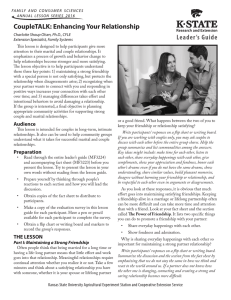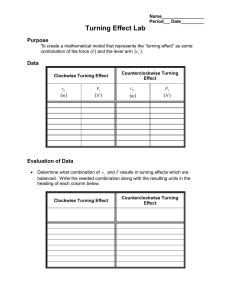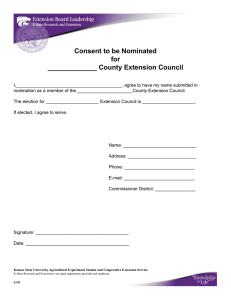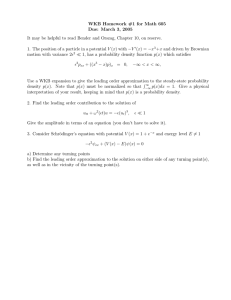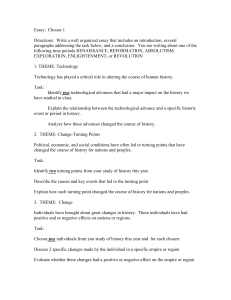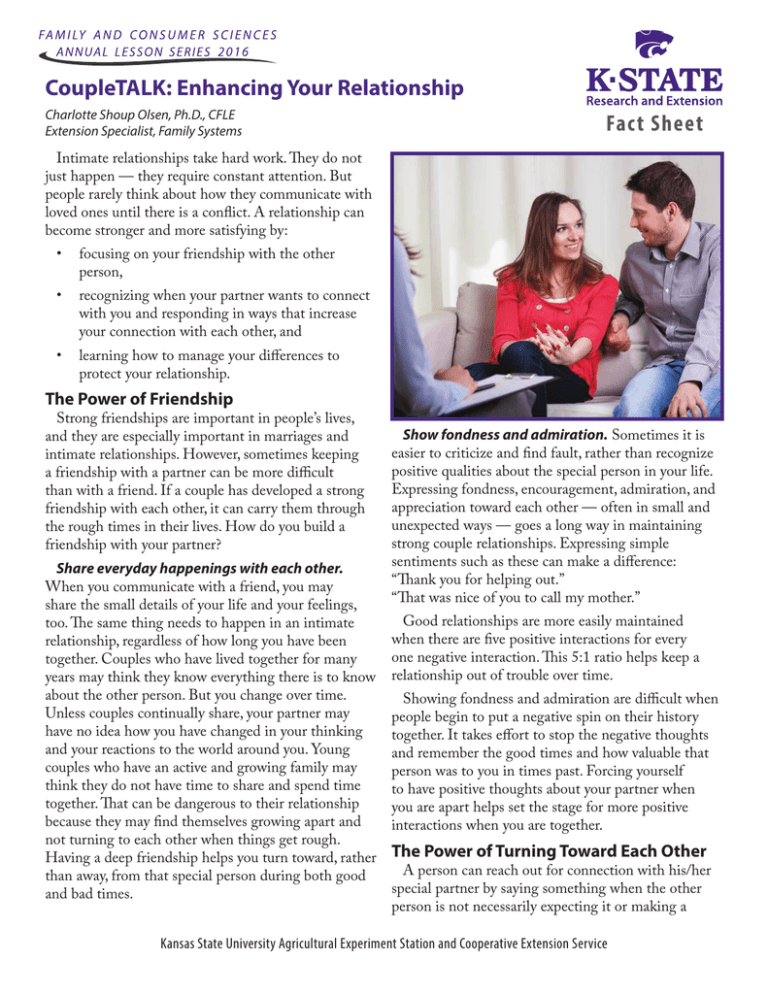
CoupleTALK: Enhancing Your Relationship
Charlotte Shoup Olsen, Ph.D., CFLE
Extension Specialist, Family Systems
Fact Sheet
Intimate relationships take hard work. They do not
just happen — they require constant attention. But
people rarely think about how they communicate with
loved ones until there is a conflict. A relationship can
become stronger and more satisfying by:
• focusing on your friendship with the other
person,
• recognizing when your partner wants to connect
with you and responding in ways that increase
your connection with each other, and
• learning how to manage your differences to
protect your relationship.
The Power of Friendship
Strong friendships are important in people’s lives,
and they are especially important in marriages and
intimate relationships. However, sometimes keeping
a friendship with a partner can be more difficult
than with a friend. If a couple has developed a strong
friendship with each other, it can carry them through
the rough times in their lives. How do you build a
friendship with your partner?
Share everyday happenings with each other.
When you communicate with a friend, you may
share the small details of your life and your feelings,
too. The same thing needs to happen in an intimate
relationship, regardless of how long you have been
together. Couples who have lived together for many
years may think they know everything there is to know
about the other person. But you change over time.
Unless couples continually share, your partner may
have no idea how you have changed in your thinking
and your reactions to the world around you. Young
couples who have an active and growing family may
think they do not have time to share and spend time
together. That can be dangerous to their relationship
because they may find themselves growing apart and
not turning to each other when things get rough.
Having a deep friendship helps you turn toward, rather
than away, from that special person during both good
and bad times.
Show fondness and admiration. Sometimes it is
easier to criticize and find fault, rather than recognize
positive qualities about the special person in your life.
Expressing fondness, encouragement, admiration, and
appreciation toward each other — often in small and
unexpected ways — goes a long way in maintaining
strong couple relationships. Expressing simple
sentiments such as these can make a difference:
“Thank you for helping out.”
“That was nice of you to call my mother.”
Good relationships are more easily maintained
when there are five positive interactions for every
one negative interaction. This 5:1 ratio helps keep a
relationship out of trouble over time.
Showing fondness and admiration are difficult when
people begin to put a negative spin on their history
together. It takes effort to stop the negative thoughts
and remember the good times and how valuable that
person was to you in times past. Forcing yourself
to have positive thoughts about your partner when
you are apart helps set the stage for more positive
interactions when you are together.
The Power of Turning Toward Each Other
A person can reach out for connection with his/her
special partner by saying something when the other
person is not necessarily expecting it or making a
Kansas State University Agricultural Experiment Station and Cooperative Extension Service
friendly gesture like a hug or smile. The other partner
has three options for responding to these bids. The
response can be:
1. turning toward,
2. turning away, or
3. turning against.
Attempt at
1. Turning Toward 2. Turning
3. Turning
Communication Response
Away Response Against
Response
“I have to get
“That’s too bad.
to work early
What kind of
tomorrow to
project is it?”
finish a project.”
“This is a great
TV program.”
“You don’t expect
me to get up
with you, do
you?” (Said in an
angry or sarcastic
tone.)
Here is an example:
Consistently “turning toward” attempts at connection build a stable, long-lasting relationship. “Turning
away” is ignoring or disregarding the other person’s
efforts to connect. If it becomes a pattern, it can be
extremely hard on a long-term relationship. Couples
who constantly “turn away” from each other shut down
their positive communication and have less experience in sharing humor, affection, and interest in each
other. They get lonely although they are together. They
are less prone to enjoy each other and solve problems
together. The third response, “turning against,” can
often be negative and angry and is not healthy for a
good relationship. Notice how the third example began
with “You …,” which often can provoke defensiveness
in the other person if spoken in a harsh and blaming
way. Although the third response is hard on a relationship, at least the couple is not ignoring each other. A
pattern of “turning toward” in everyday conversation
contributes to the 5:1 ratio in building a strong friendship that can help a couple work through difficult
situations.
The Power of Managing Differences in
Ways that Protect the Relationship
You may think the perfect couple never has conflict.
First of all, that is impossible. Secondly, healthy
conflict and disagreement are crucial to strengthening
a long-term marriage or relationship. It may seem like
you are “turning against” each other, but arguments
and disputes do not have to drive couples apart — it is
how you argue that makes the difference.
2
First and foremost, always be respectful even
when fighting. Calling each other names and other
disrespectful behavior hurts a relationship even if you
apologize later. Harmful words and actions are not
easily forgotten. Think about your body language. Does
it send a message of wanting to work together? Think
about your tone of voice. Is it sarcastic and angry or
does it send a message that you want to work out the
conflict? Think about how you listen. Are you willing
to listen and not interrupt? Or are you always more
concerned about telling your side and “winning” the
argument? Do you let your emotions fly out of control?
Or do you stop and think before you speak and act?
Think about the timing in bringing up an issue. Is your
partner busy doing something else or is it a good time
for both of you?
Conflicts that start softly tend to end on a more
positive note. Here are some tips to start difficult
conversations that are less likely to spin out of control:
1. Start with your heart. Be sensitive to the other
person, remembering that this is someone you
love regardless of your differences.
2. Begin with something positive that expresses
appreciation and gratitude. “I know we both care
about being with our families during holidays.”
3. Start with “I” instead of “you.” Example: “I would
like us to get in a routine for our holidays so we
do not have to fight about it each time.” Think
about how your tone of voice and body language
can show you are not blaming or attacking the
other person.
4. Refuse to stockpile a long list of complaints.
The other person will easily become defensive or
shut down if you go on and on about the issue.
State your needs and desires without attacking or
blaming. Make the message brief.
5. Be willing to listen to the other person without
interrupting, even when you disagree. In your
own words, tell the other person what you think
he or she is saying. It may take several times
back and forth for each of you to understand
exactly what the other person is saying. You may
be surprised that some assumptions about your
partner are wrong.
6. Work to come up with several options without
passing judgment on each option. This is a
K-State Research and Extension — CoupleTALK: Enhancing Your Relationship, Fact Sheet
brainstorming time. If you immediately dismiss
each of your partner’s ideas, that person is likely
to stop participating in this process.
7. Begin to think about the pros and cons of each
option and be ready to “give and take.”
8. Agree on an option, but be willing to revisit the
situation after a specific time to evaluate the
option. If not, the two of you need to think about
another option.
9. Show your appreciation to your partner for
respectfully working through the issue.
Calm your body in times of conflict. Think about
ways your body reacts to conflict (for example, tight
jaw, racing heart, pounding headache, tight neck
muscles). Think of ways that work for you in reducing
body stress (such as opening and closing jaws, deep
breathing, walking, stretching neck muscles). Use the
techniques that work for you to get your body calmed
down during a conflict. You may need to ask for a time
out to get your body and emotions under control, but
agree on a time to come back together. Try to have
positive thoughts about the other person and the good
times the two of you have had in the past as you are
calming down. It takes about 20 minutes for the body
to resume a normal heartbeat and pulse when it has
been stressed out.
Be willing to compromise in ways you both can
live with. This means you have to listen with an
open and honest ear to each other’s perspective and
feelings about an issue. Compromising and letting
the other person influence you helps to decrease the
hurt and pain so the problem does not eat away at the
relationship. It also helps to develop understanding
and patience with each other’s faults.
Honor each other’s hopes and dreams. Many
problems between two people result from conflicting
hopes and dreams that have not been thoroughly
discussed. Get inside the other person’s world by
listening when that person is ready to talk. You may
not agree with the hopes and dreams the other person
has, but listening attentively may eventually open
the door for more discussion. Prying needlessly or
trying to give advice will shut off the other person’s
willingness to share. Being interested in each other’s
hopes and dreams is often hard work.
A few last thoughts . . .
Healthy relationships thrive in an atmosphere
where each person feels comfortable talking honestly
and openly about important things. In this way,
minor issues can be talked about before they become
big issues that can damage the relationship. Just as
importantly, a satisfying relationship is about having
a sense of connection to the other person. It is about
spending time with the other person and having fun
together. Humor that is not sarcastic can be a great
way of reaching out to your partner — it helps you
laugh together. Establishing rituals that connect you
to each other can be very important as well. It can be
as simple as saying goodbye in a special way in the
morning as you go your separate ways or making time
to share the day’s events at the end of the day. If you
have a long-distance relationship, you will need to
become more creative in how you stay connected on a
regular basis.
To Be One With Each Other
What greater thing is there for two human souls,
than to feel that they are joined together to strengthen
each other in all labor, to minister to each other in all sorrow,
to share with each other in all gladness,
to be one with each other in the
silent unspoken memories.
By George Eliot (Mary Ann Evans)
(edited version)
This fact sheet, leader’s guide, and presentation
are not the same as counseling. The CoupleTALK
information provides a process for making a good
relationship better. If you find your marriage or
partnership in serious trouble, you are advised to seek
counseling or therapy to restore the foundation of your
relationship.
K-State Research and Extension — CoupleTALK: Enhancing Your Relationship, Fact Sheet
3
For more information on healthy relationships, contact your Kansas District/County Extension Agent in
Family and Consumer Sciences or go to the website: www.he.k-state.edu/fshs/extension
Thanks to the following persons who reviewed this lesson:
Debra Bolton, Ph.D., CFLE; Rebecca McFarland, B.S.
Written by: Charlotte Shoup Olsen, Ph.D., CFLE
Extension Specialist, Family Systems
Publications from Kansas State University are available at:
www.ksre.ksu.edu
Kansas State University Agricultural Experiment Station and
Cooperative Extension Service
Publications are reviewed or revised annually by appropriate faculty to
reflect current research and practice. Date shown is that of publication
or last revision. Contents of this publication may be freely reproduced
for educational purposes. All other rights reserved. In each case, credit
Charlotte Shoup Olsen, CoupleTALK: Enhancing Your Relationship, Fact
Sheet, Kansas State University, August 2015.
K-State Research and Extension is an equal opportunity provider and
employer. Issued in furtherance of Cooperative Extension Work, Acts of
May 8 and June 30, 1914, as amended. Kansas State University, County
Extension Councils, Extension Districts, and United States Department
of Agriculture Cooperating, John D. Floros, Director.
MF3223 August 2015

